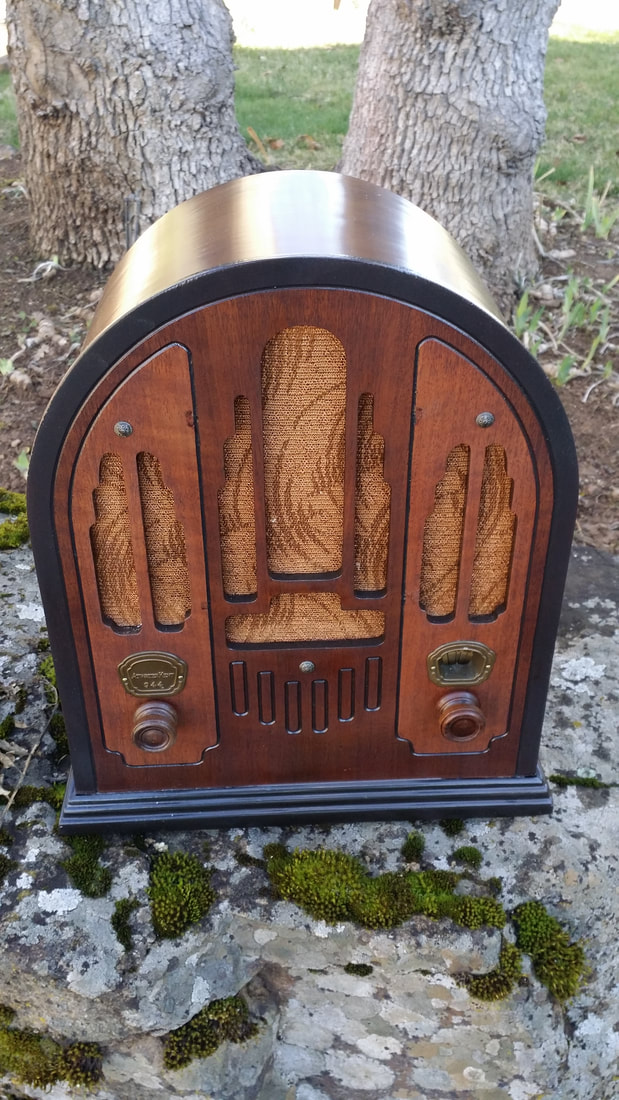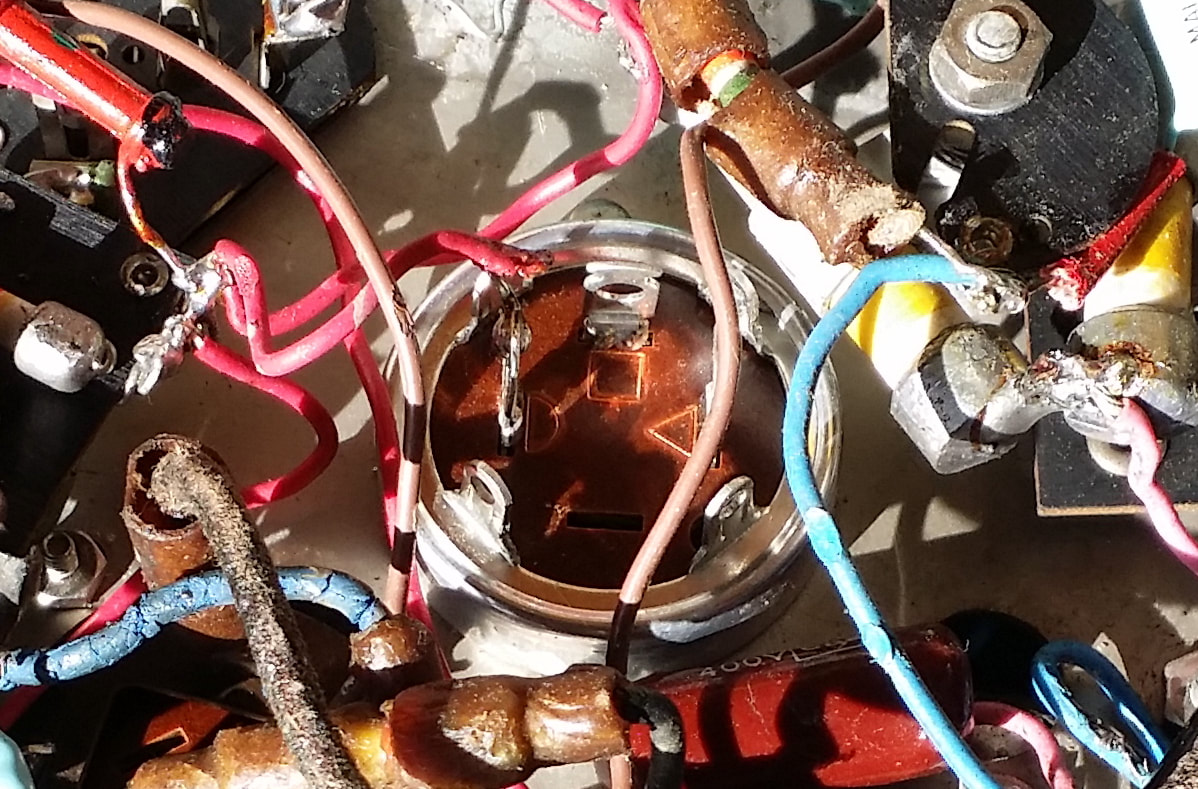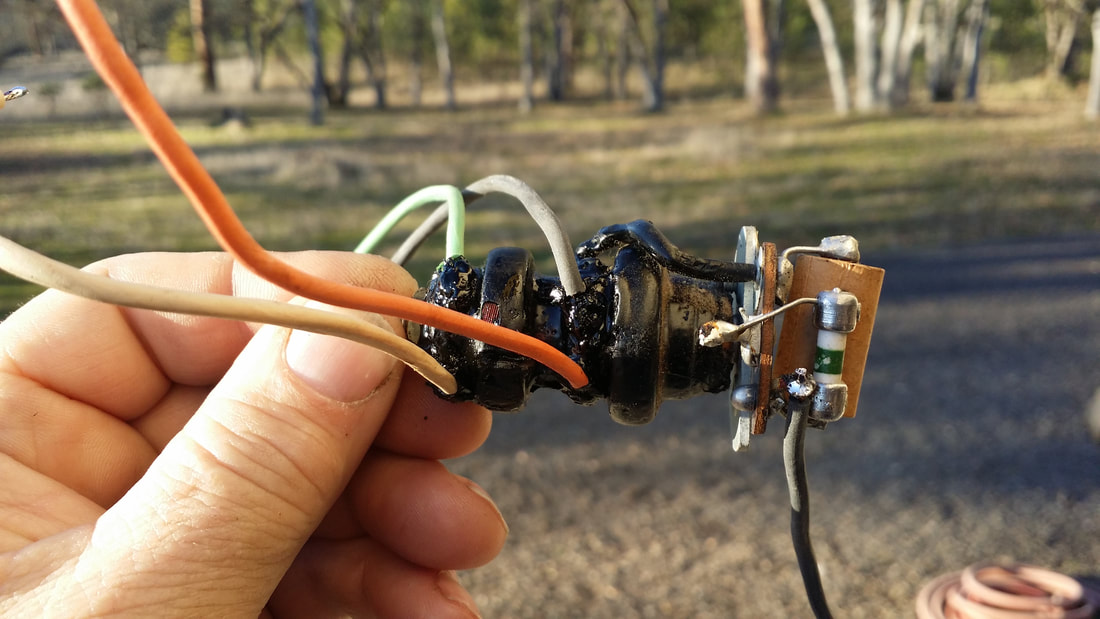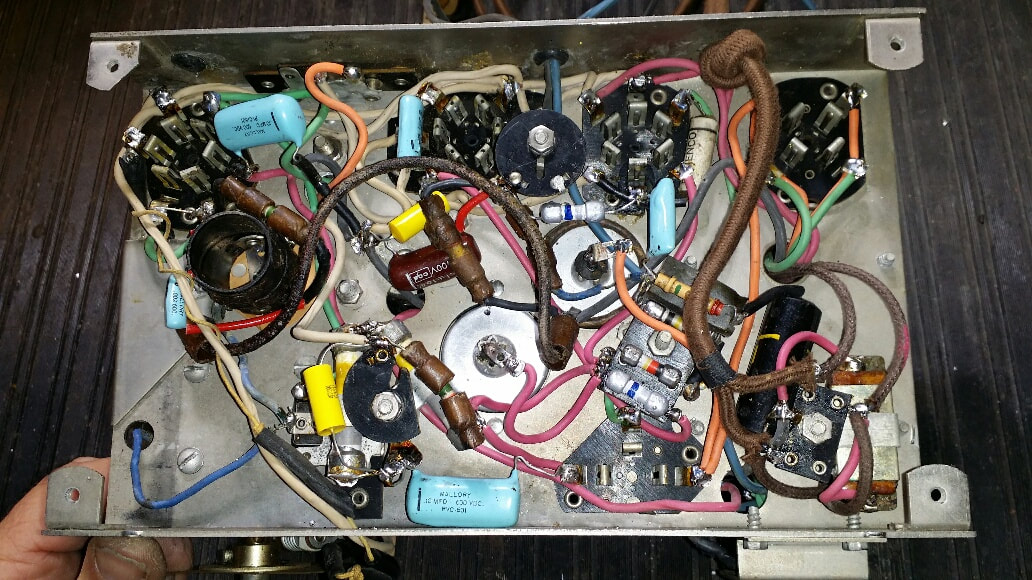"I don't feel the need to do that". Well, that is OK, don't. And this one - "No one ever looks under the chassis". To that I say it is both untrue and somewhat ridiculous, since there is much more involved. I find this of particular interest in today's environment of "MAGA" which implies that we need higher quality and workmanship - like the "good old days".
This attitude is often associated with shoddy workmanship. If the builder of your home uses less concrete in the foundation because "no one will ever see it", Let's hope the building inspector catches him. This is why antique radio buyers WANT to see the underside of the restored chassis, unless the radio is very cheap.
But don't focus too much on restuffing caps, there is a lot more to "restoration" than just the caps. Let's look at a radio I am working on right now. It is an AK (Atwater Kent) 944 from 1934/35.
This radio was working when I acquired it in a large lot last month. The cabinet had been "antiqued". The heavy paint covered up missing and split veneers and holes filled with putty - it was a total loss. So, this fellow did some less-than-perfect cabinet work. Good thing I had another cabinet!
Lets move on to the chassis. It is clear that he did have some electronic experience. He either needed to replace the original volume control or had problems with audio level not uncommon to this set. So he installed a ganged pot that also controlled bias to the audio output tube. IMO not the correct thing to do but still proving this was not his first radio.
Can I tell you a short story? Well - - Around 1992 the "cellular revolution" was in full bloom. I was a tech working for GTE (later US West, later, Airtouch, later Vodafone, later - - you get the idea). Cell phones were not cheap, especially if you had to replace one without the "bundled" contract. They were so expensive that my employer(s) feared the loss of customers that would disconnect rather than buy a new phone. It became my job to insure that this did not happen - but there was a problem. The compact design (surface mounted devices) while not new, was going to new heights with the new compact handsets. The manufactures quickly found that phones exposed to existing repair techniques were being destroyed.
The result was that almost all warranty repairs (3 year warranty) were required to be sent back to the factory. The real problem for my employer was the need to keep hundreds, maybe thousands of loaner phones since the repair process could take weeks or longer. I needed to resolve this issue.
Contacting the individual manufactures was mostly like banging your head on the wall. I approached the FTR for OKI, a nice guy that really knew what he was doing. He told me what I had suspected. It all came down to field technicians NOT KNOWING HOW TO SOLDER. OKI set up a training course for about 5 people. I found out that I did not know everything. I also found out that I did not have the proper tools. OH - ALSO there was a test.
To make a long story shorter, my employer invested thousands of $$ in all of the proper stuff - 5 element de-soldering stations with suction, static safe workstations, and a lot of parts. We became one of the first authorized field repair centers and I got a plaque for the wall. Within a few months the other manufactures fell inline. One of my most satisfying moments was when my former boss, the owner of a MSS had to bring his phone to me for repair - he was the guy that said "There is no future in consumer electronics". Also - he is out of business now.
Let's take a look at that plastic insulated wire. Do you think it is rated for 600V? Maybe it is rated for 50V or not at all. The one thing for sure is that it is a mess (and the wrong color) (And if you new guys don't think this is important, tell me where the "black" wire specified on the schematic is supposed to go.) Yeah he only had 3 or 4 colors and was not too particular as to which he used. Can you see the solder joints?
The thing I find most striking is the congestion and clutter caused by this repair technique. Let me say at this point that what you see here is above average work.
So what else can we see? Novel - the mounting of a "new" filter can - which is more than 30 years old. I'll bet it was "NOS" when he chose to use it. DO NOT use old filter caps. They generally do not age well. Anyway he pushed it up through the bottom. I think this is the first time I have seen this and while certainly creative it is not "restoration".
Glob and blob solder technique. The real trick is to get the joint HOT - FAST. Get a nice shiny joint without overheating the other components. My iron is at 800 deg.F. before I start, pig tails are cut or straitened - yeah, solder is weak. You can pull the wire out of a solder joint which is why wires/leads need to be wrapped around connections. If you have to screw with the wire/components as you make the joint you are going to burn stuff up.
Melted insulation on "new" wire. Probably going to work but it sure looks bad. Taken to an extreme, it will result in shorts. This plastic insulator melts easily. It leaves ugly burnt marks even at good joints. I have found that the new EPDM insulated wire not only looks right but the insulation is nearly impossible to scorch let alone melt.
Some of the old rubber insulated wire was just too tough to get to or replacement was deemed unnecessary. Give that blue lead on the resistor a few more years, it will be a bare wire. HOPE it does not short. When you are doing a rewire job like this, replace all of the original wire.
Extra connectors, while convenient they detract from a proper restoration. If you NEED an MP3 port, add the jack in such a way that it can be removed. Future owners will thank you.
Modern parts - detract from the "restored appearance of the chassis. Capacitors can be restuffed, if not, save the old ones for a future owner. I still need to locate the original AK caps for this unit. This is often the biggest challenge I have in doing a restoration. I also rewind or otherwise repair transformers and coils, and cast new resistors so they look like the originals.
See the new resistors? These, small AK resistors are too small for my ceramic tubes. On larger values I reuse the original lead ends. With these the whole resistor is recast and painted. Maybe one day I will start making new metal ends. (Construction is end - tube - end with a new resistor in the tube. All new resistors are at least twice the original rating but more often 4 to 12 times the ratings. For example a 1/4 watt resistor actually has a 2 watt resistor inside.
I have also heard people say "People want unrestored radios and pay more for them". Yes, I want unrestored radios. There is a lot of extra work involved with fixing a radio like this one. And, a more correct statement is that people don't want improperly restored radios - true that some people don't want to pay for the additional time it takes. BUT, even if a tech does not restuff caps or cast resistors the result should still be like the first picture above, not like the second. Many techs will find, as I did, that properly restored radios sell for a premium. If you are purchasing any radio ask to see the underside of the chassis. Restorers might already have a picture. If it is too "inconvenient" for the seller, assume the worst, don't pay much.
Some people say this takes too long. I can assure you that the first one or two WILL take too long. Is it better to have three radios restored poorly or one good one? I am not going to decide for you. I think that the real annoyance comes from owners that have paid for more and they got less or collectors that have a bunch of "repaired" but not restored radios. Sorry, I know how it feels. I have reworked many of the radios I repaired 20 years ago. Yes my skills have improved and I have found sources for better and or original (looking) parts. I have refinished one cabinet 3 times ;-)
So make your next radio the best it can be. And if you are new to the hobby - well, now you know.
Don't forget to push "like"













 RSS Feed
RSS Feed